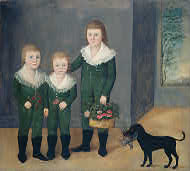
|
Joshua Johnson (artist) American, born c. 1763, active 1796 - 1824 The Westwood Children, c. 1807 oil on canvas overall: 104.5 x 117 cm (41 1/8 x 46 1/16 in.) Gift of Edgar William and Bernice Chrysler Garbisch 1959.11.1 On View |
At the center of this image is John, the oldest son of the prominent Westwood family from Baltimore, extending his arm behind and across two younger children. The smaller boys stand close together, hands clasped. All three are dressed in high-waisted trouser suits, fashionable for male children at the time, and hold a branch or flowers as if they've just returned from the outdoors. The family pet featured in the bottom right holds a bird in its mouth, clearly having found it outside as well.
Joshua Johnson's sympathetic pose of the three boys makes their brotherly relationship the subject of this portrait. A free black artist who worked in Baltimore, Maryland, during the late eighteenth and early nineteenth centuries, Johnson is known for his skillful use of design and balanced composition, as seen in The Westwood Children. His portrait style is distinguished by the oval faces, thin lips, and only slightly modeled figures of his subjects. While the stiffness of his formula often impeded character penetration, in this portrait it suggests the discomfort the children might have felt posing for the artist. Johnson's method of applying thin layers of color makes the boys' features particularly sweet and delicate.
The son of a white father and a black mother, Johnson was born into slavery around 1763 and freed in 1782. Having received minimal training in art, perhaps from one of the artists in the extended Peale family, he practiced as a portrait painter, advertising his service in Baltimore's city directories from 1796 to 1824. Roughly eighty portraits are now attributed to him.


